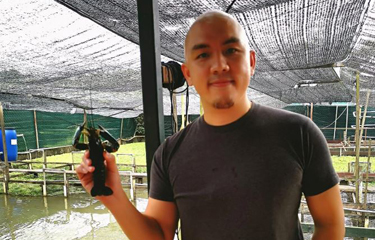A Singapore-based firm is seeking funds to build what it believes will be the world’s first specific pathogen-free hatchery.
Desmond Chow, CEO of Singapore Crawfish Pte Ltd, has the goal of producing up to 300,000 crayfish fries per day to satisfy growing regional demand for the crustacean. Chow has filed for patents for an automated system to effectively separate the crayfish adults from their craylings, or eggs. The system also boasts a 90 percent survival rate, Chow told SeafoodSource.
Chow has put SGD 2 million (USD 1.5 million, EUR 1.2 million) of his own funds into the venture and the Singaporean government has funded Chow’s research and development work, but he’s now seeking additional investors to build the hatchery. Chow said he’s seeking SGD 4 million (USD 3 million, EUR 2.48 million), but he believes the hatchery will make revenues of SGD 6 million (4.5 million, EUR 3.72) per annum once operational.
The hatchery will fill a niche need in the marketplace, Chow said, as crayfish farmers often harvest the larvae from their crayfish but complain the process is very labor-intensive.
“Female crayfish spawn two to three times a year, producing thousands of eggs each time,” he said. “Removing eggs from thousands of crayfish is very time-consuming.”
Chow sees demand in Southeast Asia and for seedlings – with growing demand in China powering consumption of crayfish into the future. With the crayfish trade in China alone worth USD 48 billion (EUR 39.7 billion), the global crayfish market size will expand by USD 10.3 billion (EUR 8.5 billion), or 16 percent per year over between 2021 and 2026, said Chow, citing market research.
A part-time academic and former socioeconomics adviser to the Indonesian government, Chow stumbled into the crayfish trade. Five years ago, he was tasked by the government to study the challenges faced by rice farmers. With 200 students helping with the analysis, Chow tracked the impact of oil prices on the cost of rice production.
“We looked at what else we could do to increase the income of the rice farmers,” Chow said.
Of the options they studied, the one with the best potential involved the uptake of crayfish farming. Through farming two species Louisiana crawfish and one type of Australian crayfish, the incomes of rice farmers in Chow’s study increased fivefold. Maintenance was low- aside from occasional feed, he said.
“Crayfish are ideal for rice paddies because they eat insect larvae, thus protecting the plants, while also nourishing them with feces. Likewise, they burrow the soil, breaking it down and making it more fertile and easier to work,” he said. “Maybe they occasionally feed a little, but there is a lot of food in the ecosystem of a paddy field. Farms would get simple vegetables. They are omnivores.”
Chow’s company currently distributes crayfish fries to farmers and has agreements with them to buy the crayfish back after a typical growing time of four months. His current hatcheries are located in Malaysia and Singapore, with fry flown to other markets in Southeast Asia, including the large market of Indonesia.
It takes seven weeks for eggs to hatch with a normal grow time of four months. At four months old, crayfish typically weigh 40 grams or 50 grams if supplemented with feed. At six months, they weigh 70 grams, or 90 grams with feeding.
“Chinese buyers prefer to finish their crayfish around the weight of 30 grams to 50 grams, but Western and European buyers prefer the larger-sized crayfish between 80 to 150 grams,” Chow said.
Chow is also in the process of patenting his own feed formula. To study crayfish dietary requirements, his team used 50 tanks and fed the crayfish a variety of feeds made up of vegetables, corn, fruit, chicken, and bovine kidney liver. They tracked their growth until they were of marketable size and refined their formula using their results.
“In comparison with other feeds, it’s relatively cheap,” he said. “From the weight they are able to yield from feeding, the feed cost is negligible.”
Chow estimated the cost of feed and seedlings at an average 30 percent of the farm-gate price of crayfish. Seedlings are around the price range of USD 0.15 to USD 0.20 (EUR 0.12 to EUR 0.17). Specific pathogen-free seedlings cost slightly more but yield them way more return, Chow said.
Growing demand across Asia and Western markets for crayfish meat is being driven by a search for environmentally-friendly sources of protein and by a broadening search for solutions to end global food insecurity, Chow said. Crayfish are “the ultimate species to solve global environmental challenges and food poverty,” according to Chow, who is also an oil trader.
“The increasing health awareness amongst the consumers is fueling the demand for crayfish in both developing and developed countries leading to the growth of the global crayfish market,” he said. “The consumption of crayfish is high in developing and underdeveloped nations where fish are eaten to solve the difficulties of malnutrition. They are an easy-to-produce food which grow in any water – even in toilet water, they won’t die. The crayfish also reproduce very quickly and abundantly.”
Chow aims to partner with major food processors in the future to process the crayfish tails into for use in instant and frozen meals, which will enable him to ship them to customers internationally.
“We currently sell the crawfishes locally, as we do not have the numbers to export. Also, because the demand of local markets alone are immense,” he said.
While China (which produced 1.8 billion tons of crayfish in 2019) accounts for 70 percent of total global crayfish production import demand is “crazy,” in part due to the seasonality of output – northerly crayfish producing regions like Liaoning and Shandong are too cold in winter for year-round output, Chow said.
Eventually, Chow’s vision is to have his high-tech crawfish hatchery franchised globally.
“This will provide food for people all around the world,” he said.
Photo courtesy of Desmond Chow







